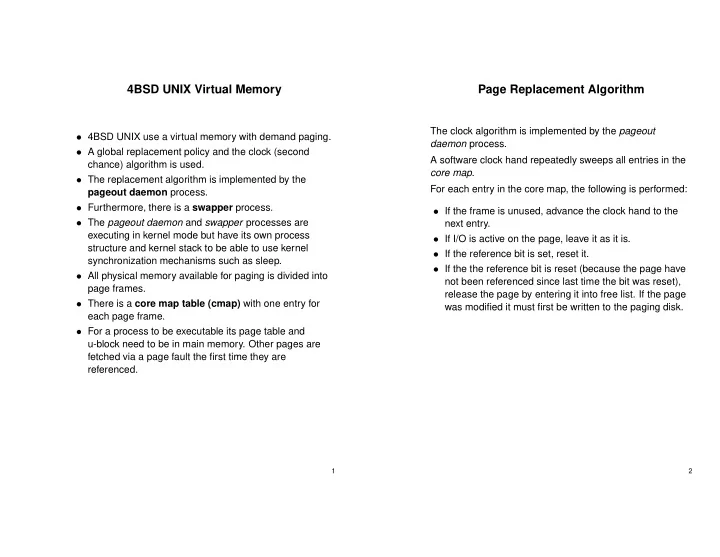

4BSD UNIX Virtual Memory Page Replacement Algorithm The clock algorithm is implemented by the pageout • 4BSD UNIX use a virtual memory with demand paging. daemon process. • A global replacement policy and the clock (second A software clock hand repeatedly sweeps all entries in the chance) algorithm is used. core map . • The replacement algorithm is implemented by the For each entry in the core map, the following is performed: pageout daemon process. • Furthermore, there is a swapper process. • If the frame is unused, advance the clock hand to the • The pageout daemon and swapper processes are next entry. executing in kernel mode but have its own process • If I/O is active on the page, leave it as it is. structure and kernel stack to be able to use kernel • If the reference bit is set, reset it. synchronization mechanisms such as sleep. • If the the reference bit is reset (because the page have • All physical memory available for paging is divided into not been referenced since last time the bit was reset), page frames. release the page by entering it into free list. If the page • There is a core map table (cmap) with one entry for was modified it must first be written to the paging disk. each page frame. • For a process to be executable its page table and u-block need to be in main memory. Other pages are fetched via a page fault the first time they are referenced. 1 2
Clock Algorithm with two Clock Hands Page Replacement Algorithm • If a large main memory is used, the clock algorithm with • The goal for the pageout daemon is to assure that there one hand do not work very well because the time to are a sufficient number of free frames available at all scan all page frames are too large. times. • On some systems an algorithm with two clock hands is • The pageout daemon is awakened every 250 ms by a used. timeout to check that there is at least lotsfree (system parameter) free page frames. If this is the case the • The first clock hand is used to reset the reference bit, pageout daemon continues to sleep. and the second clock hand releases pages with the referenced bit still reset. (they have not been referenced • If the number of free frames is below lotsfree , the clock in the time span between the scan of the first and hand will sweep a number of steps. How many steps second clock hands) depends of the number of pages needed to reach lotsfree free frames. • There is a maximum number of steps the pageout daemon is allowed to sweep at one occasion. This is adjusted so that the pageout daemon should not use more than 10% of the CPU time. 3 4
Swapping Swapping If it is discovered that the paging system is overloaded, the Swapout swapper process will be started to swap out some The swapping algorithm worked as follows: processes entirely (including page table and u-block). • If some process has been idle more than 20 seconds, The reason for using swapping is to try to avoid that the swap it out. system enters a thrashing condition. • Else select the one among the four biggest processes The swapper process is started only if the following that has been in main memory the longest time. conditions are fulfilled: The algorithm is repeated until a sufficient number of 1. Load average is high (many processes in the ready frames is available or no more candidate processes for queue). swapping can be found. 2. The number of free page frames is below a low value minfree . Swapin 3. The average number of free frames is less than desfree . with a few seconds interval, the swapper process will check (lotsfree > desfree > minfree). if some swapped out process can be swapped in again. Only the page table and the u-block is brought in by the swapper process. The pages are not fetched until they generate a page fault. 5 6
Page Fault Handler When a process references a page that is not in main memory, a page fault is generated by hardware. In principle the system will allocate a page frame for the page, read it in from the paging disk and update the page table so that the process can be restarted. In some cases the page need not be fetched from the disk: • If the page have been used earlier, it may remain unmodified in the free list. In this case the page can be re-found by a hashing search. The page table is updated and the process restarted. • Pages in uninitialized data or stack areas do not need to be fetched from disk. A free frame is allocated and initialized with zeros, and the process is restarted. 7
Recommend
More recommend